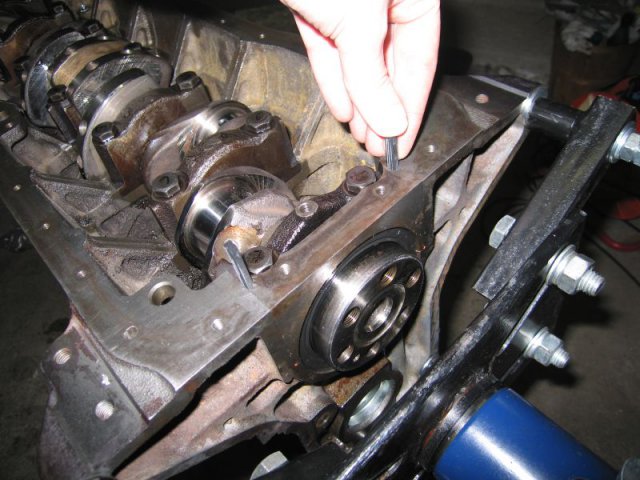-
Posts
779 -
Joined
-
Last visited
-
Days Won
2
Content Type
Profiles
Forums
Blogs
Events
Gallery
Downloads
Store
Everything posted by Lazeum
-

Weber jets??All who live for their triples please read this
Lazeum replied to datfreak's topic in Nissan L6 Forum
That's the valve that closes or opens according to the state of the accep pump system. Nothing to play with around here (except if it clogged) -

Weber jets??All who live for their triples please read this
Lazeum replied to datfreak's topic in Nissan L6 Forum
I'm placing soon the order and I've looked at how the accel system works. Pump rod change might not be the smartest move to perform. It seems I should investigate other parameters first. I've made a picture with comment to illustrate my thought. Spill Valve (the jet at the bottom of the fuel bowl, #23 on diagram) seems to be the way to go if it is not fully closed yet. I haven't seen anybody to try this route yet... -
I've seen your video some days ago and I see now your pics. It looks like something that could be done over one day. We can almost believe it is a bolt-on project. Good job and keep the videos coming, I love them!
-
For 1 second, I freaked out since I've just rebuild mine with no gasket & fit engine back last week Did not see any gasket either on manuals.
-

Weber jets??All who live for their triples please read this
Lazeum replied to datfreak's topic in Nissan L6 Forum
I will soon start again the car for the first time in nearly 2 years Before doing it, I need to order some parts for my 40DCOE. Besides the regular main, idle, air jets & chokes., I'm also looking at accel pump rod. Car besides bog at low rpm was quite snappy with no hesitation during normal operation but was not working well at low rpm (like we all experienced?) Since bog at low RPM is showing lean AFR after rich peak, I was wondering if it would worth a try to get some different pump rod design to pump more fuel during accel. My first move was to measure what I've got today in my carbs. I ended up with part number 015 in the chart below (in millimeter). My question is actually easy: what should I do to get more fuel during accel event? Obviously I need to make the stroke longer but I don't have any clue how! I foresee 3 options: 1- I reduce B length - I see no option on the chart. 2- I increase A length - easier since there're some choices; pn 012 or 016 would do the trick. 3- I get A & B to change but what kind of results should I expect? I don't also know the effect , would 1 extra millimeter of stroke make a significant difference? Should I go big to check? Rods are around 15$ per carb, I'm tempted to try -
I would measure ports in the head, you'll notice they are smaller than the ITB setup you're going to use (Ø 45 ?) So I would run a design with a taper going from head port diameter to ITB diameter. You should also think about harmonics in the intake to get the best VE possible. That would let you find the length of the runners. It should be based on air horns length also.
-
I agree with statements above about clogged vent line. A friend of mine was having the same issue, I did a drawing at that time to show him the result. I believe it is self-explanatory
-
Even with a Z, I would think twice before driving it with such stuffs
-
By welding the shaft, you'll "destroy" the hardness of the material if you don't quench it afterwards; even by doing so, you'll degrade material properties. You might end up with the balls brinelling the shaft resulting in creating some shaft play (= clunk noise) I don't know how bad you'll hurt the material but you need to take this into consideration. That's why I've drilled mine (shaft's core is not hardened) & build an insert.
-
I'm working in auto industry, shoes are also important if you want to avoid any slippage. I also use cat litter to absorb oil on the floor when required. Easy to use, cheap and easy to clean up afterwards. I have a leaf blower but it works with gas, so that's not a good idea to use it in my garage if I want to avoid intoxication...
-
I've decided to change my pump last week, I've chosen a Mallory 4070lp pump. You can even dial the output pressure of the pump & it should be very quiet. Hopefully, reliability would be good...
-
I would advise you to go look at dedicated Silvia's forums to gather info. One of the best would likely be www.sxoc.co.uk  or also www.nissansilvia.comÂ
-

I have to slam my door to shut it.
Lazeum replied to MazerRackham's topic in S30 Series - 240z, 260z, 280z
I had the issue on mine as well. I have tried to adjust anything I could. At the end, it appears weather stripping was an after market replacement. It was too thick & diffcult to install. So I went to the junkyard looking for a car with doors bigger than the Z (a coupe or a 2 doors hatchback). Modern weather stripping are extruded hollow rubber pieces that are clamped instead of being glued. It looks nice, it is new (I took mine on a wrecked car) and the doors are as easy to close as any car you could buy today at a dealership with no leaks. -
Nice project It looks like something quite original & challenging! I'm following the build for sure. I'd be curious to see how you successfully adapt everything on the original z31 chassis. Ditto for the motor/trans.
-

Engine assembly questions - rear main cap seals and
Lazeum replied to inline6's topic in Nissan L6 Forum
I use some seals coming from MSA for my rebuild, it was quite difficult to make them slip into the cavity. I tried to reuse the pin from the previous seal, it was impossible to fit - it was too tight. So I think you would be good without. I also had a set of Felpro units (I did not know they were coming inside gasket kit...), they come with flat pins as wide aas the seal. -
I agree with you. Rear main seal is at crankcase pressure. It has nothing to do with oil pressure in the system to me. I would open the breather tube to make sure crankcase is at Atm pressure and see if it is still leaking during a trial. It looks like damaged seal, groove presence in the crankshaft journal or bad seals in the crankshaft cap (the straight units or lack of silicone paste in corners of the cap). If it is a groove in the journal, next time you install a seal, don't push it all the way to avoid having the seal lip right in front of the groove, that should fix the issue.
-
That looks like something quite promising looking at reviews from Mustang users. It seems to be something fairly easy to do as long you have the ability to weld (and fit) the resonator... I'll keep this option in mind for the future since exhaust noise reduction is part of my plan in the future.
-
I will be happy to see the results of your dyno session. Besides cam. I had the same exact setup (mine was MSA 274/274) My setup use to diesel as well. Anything above 30° total advance was making my engine ping. I have changed my setup now but I'd be curious to see some "baseline" vs. how it was before.
-
You should try to find part number for your pistons, that would avoid any confusion as well. I have however a set of +0.5mm flat top in quite good shape that came out from my block (no more than 5000km). Rings are already broken in so you might need new ones but if your dished pistons are +0.5mm, rings that came with would most likely fit. They are ITM units for info. I'm travelling to Poland once a month (around Krakow/Katowice/Tychy area), I could bring them over with me if you'd be interested. Regarding cost, I was going to use them as ashtrays or pen pot so it would be small
-
So I came back from Reims where I was yesterday during the whole day for cars inspection first & then the start of the rally. It was cold (28-30°F - it is even cold for the ones living up North?!) but it was well worth it. We had the opportunity to discuss with every team & crew. All were very friendly and very nice despite pressure some hours before the start. So we've seen 3 s30 & 1 fairlady. There's was also one Honda Civic RS & 1 Mazda RX2 regarding japanese cars. The remaining cars were mostly european cars: Ford Escord RS2000, Opel GT/E, Porsches, FIat's, MG, Austin Healey, Volvo with one with 2 stroke engine (!), BMW & Renault's. All teams left Reims with Datsun stickers and Z calendar made by the club. On the way to MC, they've meet the rest of the French club, some prepared some candies with Stikers are team names on the box. They were able also to sit inside Brad's car which is truly amazing. Quick discussion with him made me understood how far he went with the replica. He reproduced Magnesium wheels based on an original one (with new dies dedicated for his build), the whole chassis with proper reinforcement based on the original car he visited for documentation, original Works calipers, reproduction of "J" sign in alumanum on the hood, steering wheel, undercarriage, exhaust, hand brake relocation, jack points, motor with appropriate valve size, head work, comp ratio, carbs, airbox, etc. Only deviations were stuffs related to safety: buckets & cages.
-
I agree but if you spend enough time reading posts on the board, the idea pops out here and there everytime! I forgot to add also the comp ratio in my list of matching parameters, which is not crazy at all (head milled by 1mm)
-
Notice that Braap did not only did my head, he was also in contact with Rebello who did a cam that matches my setup. This is the important part of the process. My combo is a matching assembly so port work, valve sizes, valve lift, spring, cam profile, etc. everything goes together for a purpose.
-
For what is worth, I was running F54, flat top, N42 and the cam you have, it was pinging & I had to retard timing by many degrees to make it work. It was not optimized but it was fun to drive anyhow.
-
I got it, I've learned something today On the other hand, looking at the harbor freight unit, it seems to be a suction type unit instead of pressure pot one. Regarding dust when doing it in a cabinet, it seems that a cyclone is the way to go to vaccum the dust. It seems quite easy to do it yourself, of course it is not applicable when doing it on a full body out of a specific room.. Here's a good link found during my research to understand better the difference between both types of blasting processes.

